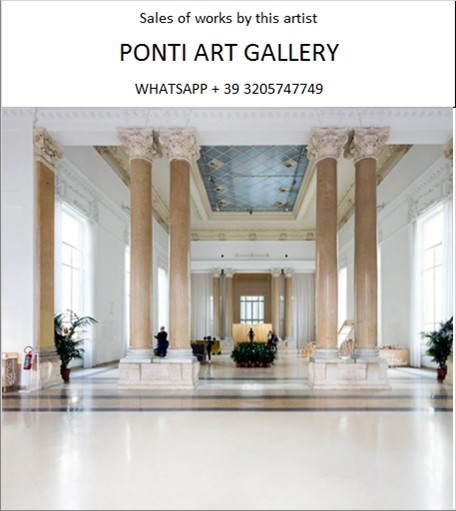Ponti Art Gallery is interested in buying and selling works
of art by this artist.

Sol Lewitt Biography
Solomon "Sol" LeWitt, born on September 9, 1928, in Hartford, Connecticut, was a pivotal figure in the development of conceptual art and minimalism. His work transcended the traditional boundaries of art-making, focusing on the ideas that generate artistic creation rather than the artworks themselves. LeWitt's legacy is built on his innovative approach to art, which emphasized the system and concept over the execution.
LeWitt's early life was marked by the death of his father, a doctor, when he was six years old. His mother, a nurse, encouraged his interest in art, taking him to classes at the Wadsworth Atheneum in Hartford. This early exposure to art would have a lasting impact on LeWitt, who later described his childhood drawings as "humorous," a quality that would subtly permeate his later work.
After receiving a Bachelor of Fine Arts from Syracuse University in 1949, LeWitt's life took a turn when he was drafted for the Korean War. During his service, he created posters for the Special Services, which allowed him to continue practicing art. Upon his return, LeWitt moved to New York City, where he worked as a graphic designer for architect I.M. Pei and at Seventeen magazine. These experiences honed his design skills and influenced his later minimalist aesthetic.
In the 1950s, LeWitt's work initially reflected the Abstract Expressionist style, but he soon began to explore a more essentialist approach to art. By the early 1960s, he was creating serial works and modular structures, focusing on the grid and the cube as fundamental forms. These early sculptures laid the groundwork for his later assertion that the idea behind the artwork was more important than the artwork itself.
LeWitt's groundbreaking perspective on art was encapsulated in his seminal texts "Paragraphs on Conceptual Art" (1967) and "Sentences on Conceptual Art" (1969). He famously declared that "the idea or concept is the most important aspect of the work," a statement that became a manifesto for conceptual art. This philosophy led to his wall drawings, which began in 1968 and eventually numbered over a thousand. These works were executed by others following LeWitt's instructions, challenging traditional notions of authorship and the role of the artist.
LeWitt's wall drawings, which ranged from layers of straight black lines to vibrant colored geometric forms, were not only monumental in scale but also in their impact on the art world. They could be recreated in different locations, emphasizing the impermanence of art and the primacy of the concept over the physical object. His work extended to other mediums, including printmaking, drawing, and sculpture, always exploring the potential of simple geometric forms and sequences.
Throughout his career, LeWitt remained true to his principles while continually experimenting with new forms and ideas. His work in the 1980s, for example, saw a shift towards more playful and dynamic compositions, incorporating curving lines and vibrant colors. This period also included public sculptures using cinder blocks, revisiting the cube in various arrangements.
LeWitt's influence extended beyond his artwork. He was known for his generosity within the artistic community, often exchanging works with other artists and supporting their endeavors. He helped establish Printed Matter, a nonprofit organization promoting book arts, and his Sol LeWitt Fund for Artists Work supported public art in New York City.
Sol LeWitt passed away on April 8, 2007, in New York City, but his influence continues to resonate. His work is held in major museum collections worldwide, and retrospectives of his art have been held at prestigious institutions such as the Museum of Modern Art in New York and the San Francisco Museum of Modern Art. The Massachusetts Museum of Contemporary Art houses a long-term exhibition of his wall drawings, ensuring that his innovative approach to art will inspire generations to come.
LeWitt's legacy is one of intellectual rigor, innovation, and a profound redefinition of the creative process. His work challenges viewers to consider the concept behind the art and the systems that generate it, making Sol LeWitt a true pioneer of conceptual and minimalist art.
Sol Lewitt Quotes and Sales of
Works
Ponti Art Gallery selects and deals with paintings by the
artist. Upon request, we provide free estimates and
evaluations, communicate prices, quotations, and current
market values.
If you are interested in BUYING or SELLING works by the
artist, contact us immediately.
If you wish to sell or receive an evaluation of the
works:
Send us a frontal photo of the painting, one of the back,
and one of the signature. Also, indicate the dimensions of
the work. Inform us about the purchase origin of the work
and any kind of available documentation (purchase
receipts, certificates of authenticity, publications). One
of our operators will respond to you on the same day. We
guarantee maximum confidentiality and extreme
professionalism.
If you wish to purchase works by the painter: Contact us
and let us know your request. We will inform you about the
available works. We also offer the possibility to
subscribe to our NEWSLETTER, through which you will be
informed at the beginning of each month about the latest
acquisitions of the art gallery.
You can send us pictures of the work:
